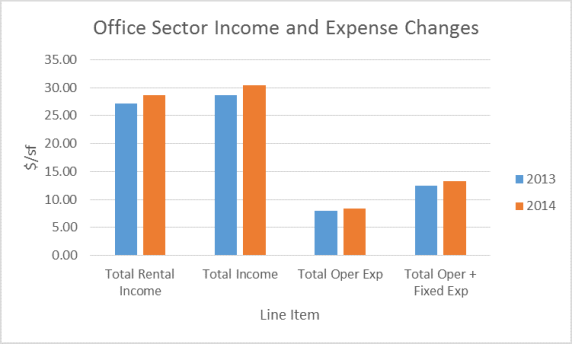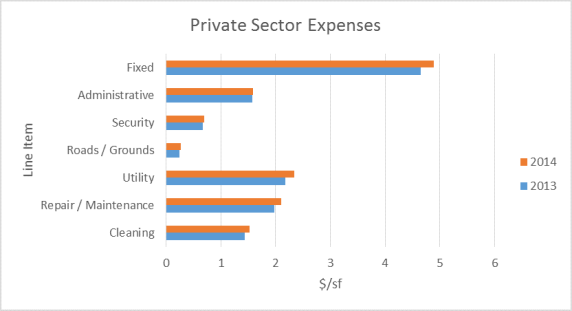The Building Owners and Managers Association (BOMA) International, in collaboration with research firm Kingsley Associates, recently released the 2015 Office Experience Exchange Report (Office EER), its annual office sector benchmarking study. The data from the 2015 Office EER shows definite increases in income levels offset by increased expenses for privately owned office buildings in the United States. A continuing trend towards densification also may be counterbalancing gains from a strengthening economy.
For the second straight year, the U.S. office sector has posted significant income growth, suggesting that the commercial real estate industry finally has turned a corner after struggling through the depths of the Great Recession. According to the 2015 Office EER, rental income for U.S. private-sector office buildings increased 5.3 percent from 2013 to 2014, and overall income for these properties climbed 6.2 percent during this same timeframe.
Accompanying these income gains were increases in total operating expenses and total operating plus fixed expenses, which rose 6.1 percent and 6.6 percent, respectively. While a considerable portion of this increase can be attributed to rising utility costs—illustrated by year-over-year utility expenses jumping a whopping 7.9 percent—the uptick also seems to indicate that buildings owners and managers are moving full steam ahead on maintenance projects and other property improvements that were put on hold during the recent recession. Repairs and maintenance expenses, for example, increased 6.2 percent from 2013 to 2014.
 Another factor potentially contributing to an increase in expenses is the continuing industry-wide trend of office densification. Reported square feet per office worker dropped another 1.5 percent in private-sector office buildings, from 293.7 square feet per worker in 2013 to 289.3 square feet per worker in 2014. This rise in office worker density can strain building infrastructure and add operational expenses, as HVAC systems work harder to cool spaces and electricity use increases to power the growing number of computers and other devices.
Another factor potentially contributing to an increase in expenses is the continuing industry-wide trend of office densification. Reported square feet per office worker dropped another 1.5 percent in private-sector office buildings, from 293.7 square feet per worker in 2013 to 289.3 square feet per worker in 2014. This rise in office worker density can strain building infrastructure and add operational expenses, as HVAC systems work harder to cool spaces and electricity use increases to power the growing number of computers and other devices.
Additional top-level office sector data from the 2015 Office EER, the largest and most comprehensive office sector benchmarking resource in the industry, can be found below. Information on specific markets in the U.S. and Canada and customizable reports based on characteristics including building type and size are available with an online subscription to the 2015 Office EER at eer.boma.org.
Private-Sector Office Building Income Trends:
- Rental income for office buildings increased 5.3 percent, from $27.19 per square foot (psf) in 2013 to $28.63 psf in 2014.
- Total income increased 6.2 percent, from $28.69 psf in 2013 to $30.47 psf in 2014.
- Base rent for office buildings increased 5.8 percent, from $21.85 psf in 2013 to $23.12 psf in 2014.
- Pass-throughs rose 7.3 percent, from $5.14 psf in 2013 to $5.51 psf in 2014.
- Revenue from escalations jumped by 13.9 percent, from $4.62 psf in 2013 to $5.26 psf in 2014.
Private-Sector Office Building Expense Trends:
- Total operating expenses increased 6.1 percent, from $7.96 psf in 2013 to $8.45 psf in 2014.
- Total operating + fixed expenses increased 6.6 percent, from $12.49 psf in 2013 to $13.32 psf in 2014.
- Roads and grounds expenses increased 8.1 percent, from $0.25 psf in 2013 to $0.27 psf in 2014.​
- Utility expenses jumped 7.9 percent, from $2.18 psf in 2012 to $2.35 psf in 2013.
- Cleaning costs increased 6.2 percent, from $1.44 psf in 2013 to $1.53 psf in 2014.
- Repairs and maintenance increased 6.2 percent, from $1.98 psf in 2013 to $2.11 psf in 2014.
- Fixed expenses increased 5.1 percent, from $4.65 psf in 2013 to $4.89 psf in 2014.
- Security expenses rose 4.8 percent, from $0.67 psf in 2013 to $0.70 psf in 2014.​
Private-Sector Office Building Occupancy Trends:
- Occupancy rates increased 1.0 percent, from 88.2 percent in 2013 to 89.1 percent in 2014.
- Reported weekly operating hours decreased by 1 percent, from 73.9 hours in 2013 to 73.1 hours in 2014.
- Reported square feet per office worker saw a 1.5 percent drop, from 293.7 square feet per worker in 2013 to 289.3 square feet per worker in 2014.

“The commercial real estate industry has been slow to emerge from the shadow of the recession, but the latest data from BOMA International’s 2015 Office EER shows positive signs of growth for the office sector,�? commented BOMA International Chair Kent C. Gibson, BOMA Fellow, president of Capstone Property Management, L.C. “Property professionals will need to adapt to the realities of increased densification and rising utility costs to keep their buildings—and the industry—thriving.�?

